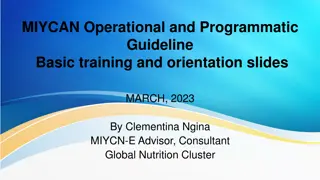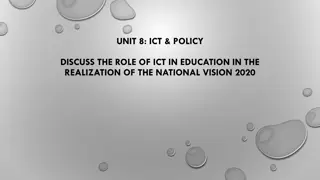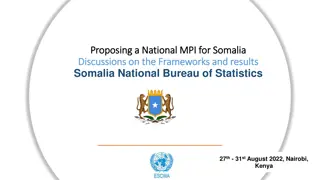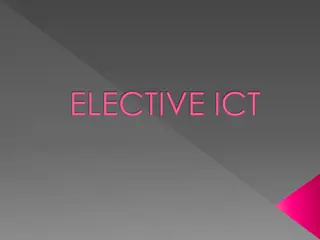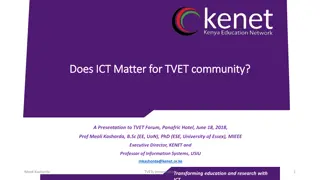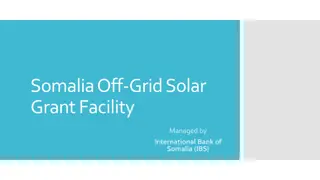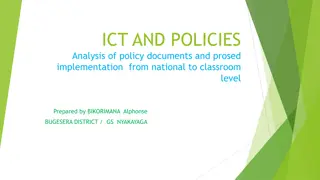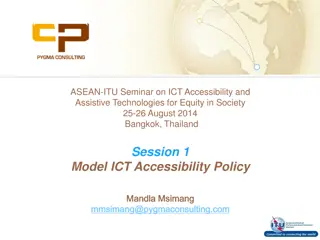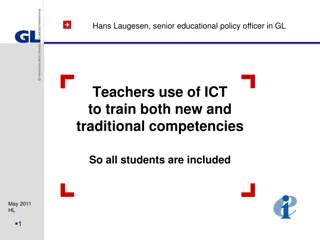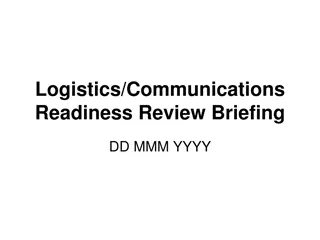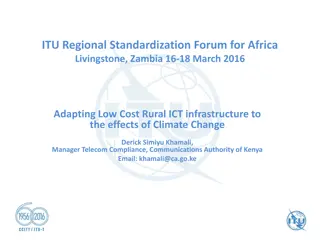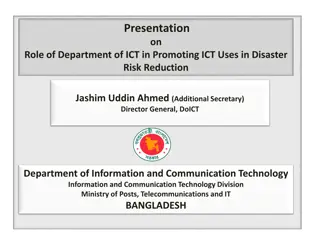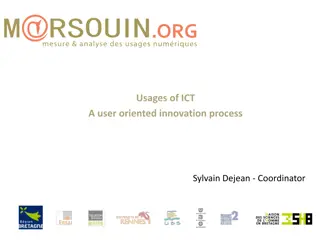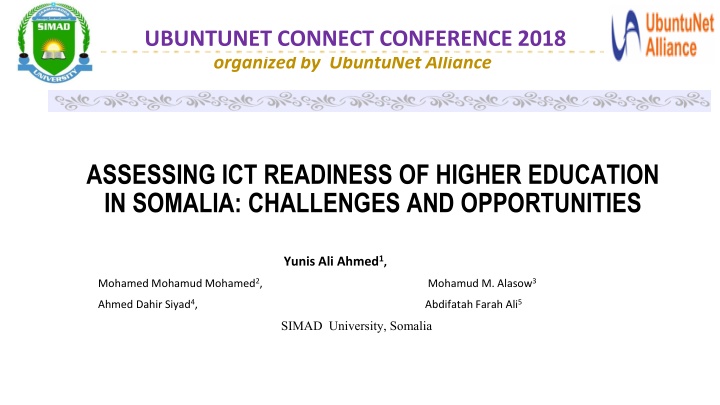
Assessing ICT Readiness of Higher Education in Somalia: Challenges and Opportunities
This research paper explores the ICT readiness of higher education institutions in Somalia, assessing current usage levels, preparedness, and societal attitudes towards ICT for teaching and learning. The study methodology, sample selection, and proposed e-readiness assessment model are discussed, highlighting the importance of ICT infrastructure and relevant indicators for assessing readiness.
Download Presentation

Please find below an Image/Link to download the presentation.
The content on the website is provided AS IS for your information and personal use only. It may not be sold, licensed, or shared on other websites without obtaining consent from the author. If you encounter any issues during the download, it is possible that the publisher has removed the file from their server.
You are allowed to download the files provided on this website for personal or commercial use, subject to the condition that they are used lawfully. All files are the property of their respective owners.
The content on the website is provided AS IS for your information and personal use only. It may not be sold, licensed, or shared on other websites without obtaining consent from the author.
E N D
Presentation Transcript
UBUNTUNET CONNECT CONFERENCE 2018 organized by UbuntuNet Alliance ASSESSING ICT READINESS OF HIGHER EDUCATION IN SOMALIA: CHALLENGES AND OPPORTUNITIES Yunis Ali Ahmed1, Mohamed Mohamud Mohamed2, Mohamud M. Alasow3 Ahmed Dahir Siyad4, Abdifatah Farah Ali5 SIMAD University, Somalia
The Outlines Introduction 1 Study Methodology 2 ICT readiness assessment Model 3 The study results 4 Conclusion 5 2
Introduction Living in the information age, the rapid development of the Information and communication technologies (ICT) has been played an important role in the various activities aspect of human live including education (Buabeng-Andoh and Yidana 2014, Liu, Toki et al. 2014, Ko , Turan et al. 2016). Background In Somalia, since 2000 there has been a big push to introduce computers include hardware, software into higher educations. Accordingly, universities have been initiated to spend a tremendous amount of money to improve their ICT infrastructure to support teaching and learning (Harry, 2007). The use of ICT tools through higher education institution in Somalia is still in early stages of development. Due to its newness in Universities, ICT may not be well accepted by higher education communities in Somalia. Existing problem/gap However, no research studies have been conducted so far with the aim of determining the ICT readiness of Somalia higher institutions towards teaching-learning perspectives. Therefore, the main objectives of this research are: 1. To understand the ICT preparedness of Somali higher education institutions 2. To identify the current level of ICT usage in Somali higher education institutions 3. To evaluate the society attitude towards ICT usage for teaching and learning perspectives The study objectives 3
Methodology Sample In this study, 30 public and private Somali higher education institutions were selected. The selection of Universities was based on the date of establishment (before 2012) and student populations (more than 1000). The Universities were selected across all Somali regions. The sample was heterogeneous faculty members, administration staff and senior students. A total of 300 questionnaire copies were distributed through out 30 universities, 272 were returned, representing 91.0% return rate. 4
Proposed Model And Indicators Several e-readiness assessment tools and models related to ICT have been specifically designed and used. However, these tools are not suitable for use to asses such country like Somalia. Thus, this study borrowed some indicators from different existing E-readiness models and we added a new indicators to determine in-depth problems related ICT Preparedness in HEIs of Somalia.
Proposed Model And Indicators ICT Infrastructure Institutional ICT Learning - - - Access to own computer or sharing Internet access Campus Infrastructure(campus network) Internet affordability Network speed and quality (QoS) - - - Technology and tools Adequacy of ICT skills Availability of adequate local content - - ICT Readiness ICT Strategy & Planning Society Attitudes towards ICTs - - - - ICT strategy and policy ICT financing ICT human skill development ICT Security - Management awareness for ICT importance Staff understanding of benefits ICT -
Proposed Model And Indicators 14 indicators categorized as following: ICT Infrastructure: contains five (5) indicators:- Access to own PC or Shared Computers, Campus Networking and Environment, Internet Availability, Internet Affordability, and Network Speed and Quality. Institutional ICT Learning: has the following three (3) indicators: Technology and Tools, Adequacy of ICT Skills, and Availability of Adequate Local Content. ICT Strategy and Planning: Comprises five (4) indicators: ICT Financing, ICT Strategy, ICT Human Skill development, and ICT Security. Society Attitudes Towards ICT: two (2) indicators : Management Awareness for ICT Importance and Staff Understanding of ICT Benefits The scale of each indicator and its sub-indicators is 1- 4 7
Overall Performance of all Indicators Access to own PC or Shared Computers Staff understanding of ICT benefits Campus Networking and Environment 4 3.5 2.9 2.94 3 Management Awareness for ICT Importance 1.4 Internet Availability 2.5 1.99 1.5 2 1.5 1 ICT Security Internet Affordability 0.97 0.78 0.5 0 2.5 2.6 ICT human skill development Network Speed and Quality 1.45 2.19 ICT Strategy Technology and Tools 2.08 1.44 0.64 ICT Financing Adequacy of ICT skills Availability of Adequate Local Content 8
At stage At stage Opportunities Challenges 0.64 Access to own PC or shared Computers Availability of Adequate Local Content 2.9 0.76 Staff understanding of ICT benefits 2.94 Management s Attention to the ICT importance 0.78 ICT Financing ICT Security and strategy policy 2.08 0.97 Network Speed and Quality Internet affordability 2.6 9
ICT Infrastructure Indicators Access to own PC or Shared computer: % of students having their own computers or have the access to the shared computers AND the % of the staff having own computers or have computers provided by the institutions. Campus Networking and Environment: Availability of Campus Network, Networking Equipment, Sharing Platform, Availability of Backup Power Source, Availability of off-side Backup, and Campus Network Plan Internet Availability: Availability of Internet facility, Available Internet Bandwidth, Internet Access to the students, The type of Internet Package, Internet Bandwidth Management, Number of Connected Users, Type of Internet Connectivity, and Available Internet speed per 1000 students. Internet Affordability: Internet Bandwidth cost per Mb/s AND % of Internet bandwidth cost to the total budget Network Speed and Quality: Connection quality AND Quality of ISP Services Availability of Data Centers, 11
ICT Infrastructure Indicators shared Computers 4.0 2.9 3.5 3.0 Campus Networking and Environmen t 2.5 Network Speed and Quality 2.0 1.5 2.6 1.0 1.4 0.5 0.0 1.0 1.5 Internet Affordability Internet Availability 12
ICT Infrastructure: Overall sub-indicators Computers 4.0 Quality of ISP services % of Staff access of Computers 3.5 Connection quality Availability of Campus Network 3.0 2.8 2.7 3.0 Percentage of Internet bandwidth cost to the total Networking Equipment 2.6 2.5 0.8 2.1 2.0 Internet Bandwidth cost per Mb/s 1.9 Availability Sharing Platform 1.5 1.2 1.0 2.3 0.5 Type of Internet Connectivity Availability of Data Centers 0.8 0.8 0.9 0.9 0.0 2.0 Availability of Backup Power Source Number of Connected Users 1.5 0.5 0.8 0.9 1.7 Internet Bandwidth Management Availability of off-side Backup 1.5 Availability of ICT Campus Network Strategy Plan The type of Internet Package 3.2 Available Internet Bandwidth per 1000 Students Availability of Internet facility Available Internet Bandwidth Internet Access to the students 13
Institutional ICT Learning Indicators Technology and Tools: Educational software and technology tools, Technology Tools for Research, Availability Systems, ICT facilities in Classroom, and Availability of Integrated Campus Management System of Course Management Adequacy of ICT Skills: Ability of University s staff to use ICT Educational Tools, Dedicated Department for ICT Administration, # of ICT staff having Professional Certificates, # of ICT staff who are trained as Network Administrators, and Frequency of ICT workshops Availability of Adequate Local Content: Content, and Availability of International Online Academic Databases. Availability of Locally Created 15
Institutional ICT learning Technology and Tools 4.0 3.5 3.0 2.5 1.5 2.0 1.5 1.0 0.5 0.0 0.6 1.4 Availability of Adequate Local Content Adequacy of ICT skills 16
Institutional ICT learning Educational software and technology tools 4.0 Availability of International Online Academic Databases Technology Tools for Research 3.5 3.0 2.5 Availability of Locally Created Content Availability of Course Management Systems 1.7 1.2 2.0 1.5 0.80.5 1.0 0.5 0.5 1.7 1.3 Frequency of ICT workshops ICT facilities in Classroom 0.0 1.5 2.6 # of ICT staff who are trained as Network Administrators Availability of Integrated Campus Management System 2.0 2.1 2.4 # of ICT staff having Professional Certificates Ability of University s staff to use ICT Educational Tools Dedicated Department for ICT Administration 17
ICT Strategy and Planning ICT Financing: % of ICT Expenditure Annually ICT Strategy: Overall Status of ICT, Reporting level, ICT leadership, and ICT awareness by staff and students ICT Human Skill Development: Qualifications of ICT Staff, and Frequency of upgrading skills for ICT staff ICT Security: ICT Security Strategy 19
ICT Strategy and Planning Indicators ICT Financing 4.0 3.5 2.1 3.0 2.5 2.0 1.5 1.0 0.5 ICT Security ICT Strategy 0.8 2.2 0.0 2.5 ICT human 20
ICT Strategy and Planning: overall Performance % of ICT Expenditure Annually 4.0 3.5 ICT security strategy policy Overall Status of ICT 2.1 3.0 2.5 2.0 2.0 1.5 0.8 1.0 0.5 Frequency of upgrading skills for ICT staff 2.2 2.3 Reporting level 0.0 1.7 2.9 Qualifications of ICT Staff ICT leadership 2.8 ICT awareness by staff and students 21
Society Attitudes Towards ICT Importance: Management Management s Attention to the ICT importance, Staff s Awareness for the ICT importance, and Management/staff Supports towards use of ICT Awareness for ICT Staff understanding of ICT benefits: Does ICT Tools Help in Performing Different Work Activities, The use ICT allows Staff to obtain resources or information easily, and Does ICT help you in the treatment of students with special educational needs 23
Society Attitudes Towards ICT Management s Attention to the ICT importance 4.0 3.5 3.0 Does ICT help you in the treatment of students with special educational needs 2.5 Staff s Awareness for the ICT importance 2.0 3.0 2.7 1.5 0.8 1.0 0.5 0.0 2.6 3.1 The use ICT allows Staff to obtain resources or information easily Management/staff Supports towards use of ICT 2.8 Does ICT Tools Help in Performing Different Work Activities 24
Conclusions In this paper the ICT readiness assessment model was developed and tested with 30 public and private Universities in Somalia. The model is composed of 14 indicators which each indicator also has sub-indicators. The results shows that: Somali HEIs ICT readiness is 46% - less management attention of ICT importance in education - Inadequate campus networks in HEIs. - Difficulty in internet affordability - Lack of adequate local contents - Lack of ICT security plan and awareness 25




